First up, a 75mm Maxim-Nordenfelt cannon that was on display at the Carabinieri Museum in Rome. Guns like this one were pretty widely used by countries all over the world, with a wide variety of details in the carriages. This particular example is (according to its display tag) an 1886 model gun. The action is marked Maxim Nordenfelt 1.65 Mark E I, which tells us a few things. The Maxim-Nordenfelt company only existed from 1888 until 1897 (when it was bought up by Vickers to become Vickers, Sons, and Maxim), so assuming the tag is correct about this being an 1886 model gun it would be a Nordenfelt design that remained in production after the Maxim and Nordenfelt companies merged.
The 1.65 and Mark E I notations also have a meaning, although I have been unable to definitively identify them. The 1.65 number seems most likely to be a powder charge (in pounds), as it is too small to represent the bore in inches or the projectile weight in pounds. I don’t have any good print resources on the quick-firing guns of this era above 37mm, so I can’t point to exactly what a Mark E I designates.
At any rate, the gun was apparently captured by Carabinieri soldiers in June of 1936 at the Battle of Dessie, in Ethiopia. A few other details on the gun from its tag:
- Bore: 75mm
- Barrel length: 1000mm
- Rifling: 12 groove
- Wheel diameter: 710mm
- Carriage weight: 150kg
- Total weight: 250kg
Perhaps someone with more knowledge of antique artillery can provide some details on the gun in the comments?
Second, Othais and Mae at C&Rsenal have a video up on the Type 30 Arisaka, which is excellent and well worth watching. The video work they are doing has been getting better and better, and if you aren’t watching them, you should be!

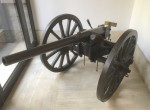

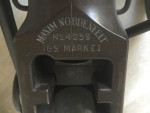
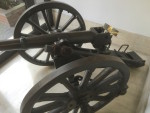
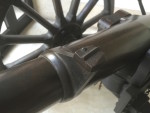

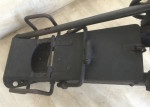
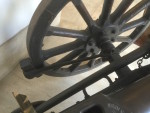
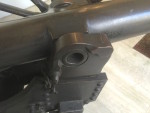
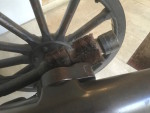
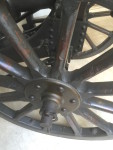
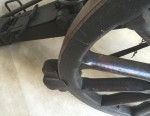
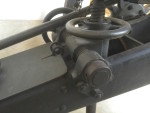
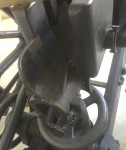
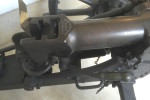

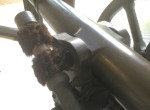
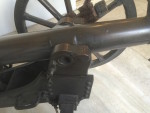
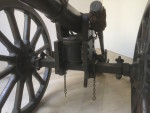
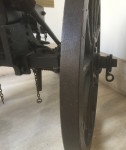
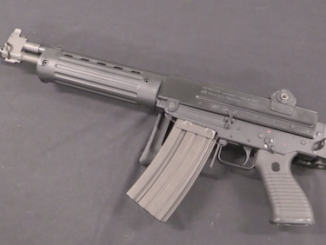
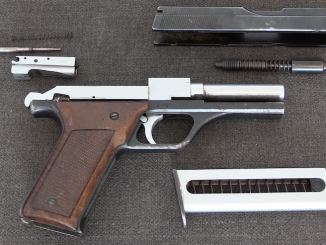
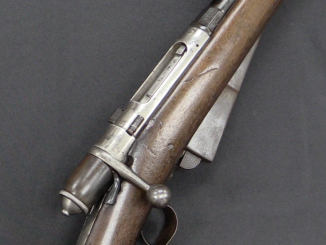
“Perhaps someone with more knowledge of antique artillery can provide some details on the gun in the comments?”
I can’t find any technical details so far, but I found Appendix 1: Record of work carried out by the Artillery Branch of the Headquarter Staff, South African War here: http://www.gutenberg-e.org/mas01/archive/app01.html implying that 75 mm. Q.F. gun (Maxim-Nordenfelt). was Captured from the enemy and taken into use. during war in South Africa.
That was a newer model with a recoil buffer, interrupted screw breech and longer barrel, which was used by both sides of the Second Boer war in small numbers:
http://www.victorianwars.com/viewtopic.php?f=21&t=9157#p44626
The gun in question seems to have a vertical sliding wedge breech, no recoil buffer and it’s light enough to be carried by pack animals in four pieces. Accordingly barrel is short (about L/15), which was typical for pack guns. This gun was probably not adopted by any major power, which explains the lack of information.
Hmm… commercially sold artillery pieces like this are rarely found in the books if only because the company has no obligation to tell us what it was doing at the time. Equally unlikely to be found is the 37 mm Hotchkiss auto-cannon (the infantry support gun based on the 1897 machine gun, not an anti-air or anti-tank)…
Weapon of choice scenario:
Given a choice of outdated artillery, which do you think is best for protecting the crumbling coastal fortress and the nearby harbor from ruthless modern pirates? I’m talking about the kind who will hijack cargo ships for ransom by means of RPG-7 aimed at the bridge.
1. QF 6 pounder Hotchkiss
2. Nibelwerfer
3. 7.5 cm Pak 40
4. M1919 Coast Gun
5. 28cm Kustenhaubitze
6. 12.7 cm Type 89 AA two-gun turret
7. 12.8 cm Flak 40 or Pak 44
8. Medieval trebuchets hidden in the nearby woods (at least fifty of the 300 are serviceable)
9. Screw the budget! Call air support or add your favorite toys to this list!
If by any chance the pirates get into the fort, I’ll have to break out the FN Model 1949’s and MG-34s. In any case, this activity is voluntary. You aren’t required to participate if you do not wish to do so. Please keep any and all criticism of this post humane and free of foul language.
Thank you,
Cherndog
Modern pirates use relatively small vessels, so the 57mm Hotchkiss is pretty much the only one that makes sense. Fast 360 degrees traverse and high rate of fire made it an effective gun against small vessels and many were used even as late as WW2 for harbor and close defense of coastal artillery installations.
And what if the pirates brought in a bigger ship? If they’ve got a “mother ship,” which is very likely a stolen cargo ship or large fishing vessel, one would need a bigger gun (or simply more 6-pounders) to deal with it.
if you want to inflict serious damage on a ship, the 15cm Nebelwerfer would be hard to beat. Each round weighed about 37 kg, about 30% of it the HE warhead. Range was about 5500 meters, and while accuracy of fire wasn’t up to tube artillery, it made up for it in rate of fire; all six rounds could be discharged in about 30 seconds.
And after all, a “mother ship” will be at least a distant-waters trawler or the equivalent, so it’s a pretty big target that won’t be moving too fast; ten to fifteen knots on average. The dispersion of the Nebelwefer at about 1800-2000 meters would pretty much “walk the burst” along its length on a broadside shot with a little “nudge” to the mount between shots.
For an even more agricultural alternative, look up the Schweres Wulfgerat. Basically a 21cm Nebelwefer rocket motor hooked to a 28cm diameter “head” full of either HE or incendiary mixture. Delivered in a wooden frame “crate” that was also the launcher; just prop up the front end on something to get the elevation you wanted, hook up the firing leads, stand way to one side, and give the blasting box handle a twist. Range was about 2000 meters.
Not something you want landing in your well deck. Or coming in a bridge window.
cheers
eon
So that means the rockets will get rid of the big ships, the 6-pounders will target skiffs and speed boats, and the small arms will be reserved for any surviving pirates who somehow make it to shore and still wish to fight… Or am I wrong?
Rocket artillery is not designed to fire at moving targets and the large dispersion introduces an additional random element. So, I wouldn’t risk using it if you could choose 5″ artillery pieces (6. & 7.), which would be quite efficient against unarmored ships. Only the PaK 44 would be questionable in anti-ship role due to limited traverse.
@Euroweasel
So that leaves the Type 89 turret and the Flak 40 then (12.8 cm Flak has 360 degree traverse, and it can fire HE which would be nasty for anything without thick armor on the receiving end). I suppose the Adolf Gun would be overkill for pirate-sinking, but who knows?
If you really want to be serious in taking out ships I would recommend the good old 5″/38 of WW2 fame. With a twin turret you get both volume of fire, accuracy and a powerful HE projectile. For small Boat or really close in how about the powered 40mm Obe? There were 1,2 and 4 barrel versions.
If the pirates are within 1000 M and swarming the harbor, I would actually prefer an old Civil War 20″ Rodman filled with 1000 Lbs of 1″ ball bearings. Kind of a Shotgun on steroids. From the list,the 12/8 cm Pak 44 would be nice, but I would prefer its sibling the 12.8 cm Pak 80 in a Jagtiger mounting skurzen to predetonate the RPG rounds and really cause them to think about going elsewhere (typical,as my other handle is JagtygerII). Besides, it would go well with the MG 34
I’m a fan of the novels of South African author Wibur Smith (“Shout At The Devil” is a rollicking read about Germans and English in East Africa during WW1, and made a great movie starring Lee Marvin and a very young Roger Moore.) One of my favorites is “Cry Wolf” (which would have made a great film) about a couple of expats trying to make a living in 1930s Africa, and get involved with trying to smuggle some obsolete WW1 armored cars into Ethiopia around the Leauge of Nations embargo – which affected the Ethiopians (knowing that an invasion was imminent) much more than the Italians. Great read about a nearly-forgotten and mindbogglingly unjustified muskets-against-tanks conflict, if not a very flattering look at the Italian prewar military.
One of the companies which went into the “Vickers” industrial combine, had a works in Napoli.
IIRC it was Armstrong.
Yes, it was Armstrong. The Armstrong works were separate from the Vickers-Terni company, which ended in 1922 when Terni bought out Vickers. The Terni weapons works later became the OTO-Melara company, which is nowadays a subsidiary of Leonardo Finmeccanica.
in july 1941, the Italians attacked the Grand Harbour of Valetta , Malta with MTB’s, manned torpedo’s and “suicide boats”. The harbour defenses used double mounted 6-pounder QF’s and shot them up pretty bad.. so, i guess they will do the job against modern small boats too. And eat the mothership as desert.
I think you meant to say “dessert” in your last sentence, but that’s beside the point. 6-pounder guns would certainly wreck speedboats and pirate skiffs. The only question left is whether the mothership would steam close enough to the harbor for you to hammer her with 6-pounder guns. One of the only fates for ships worse than being chewed to pieces by 6-pounder guns is likely being set ablaze and sunk by Japanese 12 inch Shimose powder HE shells. I could be wrong…
A small story about the Maxim-Nordenfelt cannon during the Boer War. In January 1896 Jamieson lead his infamous raid into the Transvaal. For this incursion two Maxim Nordenfelt were purchased. Only one arrived with its carriage intact in time for the raid. This gun (serial 4116) was captured by the Boers. The second (serial 4115) was eventually united with its carriage and served the British South Africa Company in Rhodesia. In February 1900 a skirmish took place in the Metsi Mashoane Valley between Boer and Rhodesian forces. Ironically, of all the Boer artillery available, Jamiesons’ piece was allocated to the Zoutpansberg Commando. Here it came up against its brother under Lord Plummer’s Rhodesians. Both survived to fight another day. Such are the ironies of war.